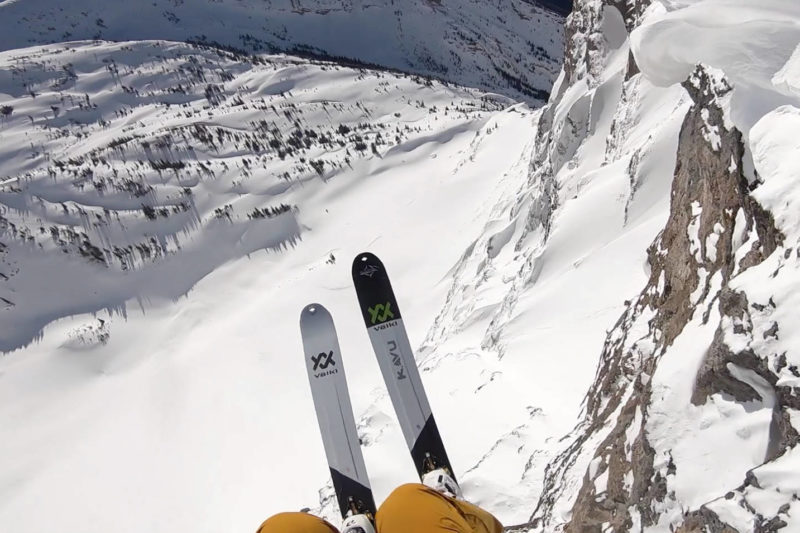This winter, when you’re out adventuring in the backcountry, you might stumble upon some ski tracks that appear out of nowhere, or disappear without a trace.
These ghost tracks, although seemingly from a legend, belong to a reclusive group known as speedriders.
Requiring just a small parachute like wing, a set of skis and a thirst for adventure, this niche hybrid sport combines two amazing things; skiing and flying.
Access for speedriders in Fernie is all in the backcountry, primarily by ski touring up or using snowmobiles.
Most times, the effort it takes to reach the point of take-off is substantial. What could take hours to ski tour up may be over in a minute once the rider sets off. Descending down the mountain, speedriders can fly above the ground at speeds of 80-130 km/ hr., interacting with the terrain by touching down to make turns then taking off again, leaving only a set of ghost tracks in their wake. Their ability to fly allows them to decorate a slope with ski tracks down unskiable terrain that may end in massive cliffs.
The sport of speedriding has developed over the years since the 70s and 80s as European mountaineers started using parachutes to descend mountains quicker. In the past 10 years, there have been incredible advancements to speed wings, which can range in size from 6m to 15m; a third to half the size of a paraglider.
Lance Edwards of Fernie was introduced to this incredible sport at a mountain lm festival in 2010. He watched a film in awe as one of the sports’ founders, Francois Bon, gracefully made his way down the famous Eiger, combining flying with skiing. Edwards knew at that moment he had to try it for himself.
After a lot of homework researching this new sport of speedriding, Edwards discovered there are two ways to safely learn to speedride. The most common way in North America is to learn how to become a proficient paraglider first. This involves taking lessons and completing a paragliding school, learning to understand the respect for weather conditions, wing control, flight planning, takeoffs and landings.
Paraglider wings range from 20-30 square metres which allow paragliders to catch thermals to gain elevation, and can stay up in the air for hours. For progression to a speedwing, in time, a paraglider can slowly downsize their wing which allows them to gain more speed and decrease their glide ratios.
The only other way to safely learn the sport is to complete a training program specifcally for the speedriding. There are many schools in Europe that offer these focused training programs, including the one that Edwards attended. In 2013, he and good friend Ryan Dale-Johnson chose the Europe option and attended the well-known Speedriding School in Les Arcs, France. Edwards says that chairlift accessible terrain with world class coaching was the perfect combination to learn. He explained that over there, one can complete more flights in a few days than you can in an entire season back home. After their schooling, the now-certified speedriders bought wings of their own and have been hooked ever since.
Speedriding has allowed Edwards to cross an item off his bucket list; to place a ski track right off the middle ski jump feature of the Three Sisters in Fernie.
On the top of middle sister, he stands in the snow, his wing laid out on the ground behind him. Like a pilot, he runs through his preflight safety checks, ensuring harness is secure, lines are laid out correctly, and a final wind check is completed. Sliding forward, he picks up speed, allowing the wing to rise up over his head. Looking up, Edwards checks his lines again, ensuring no that there are no tangles and that all wing cells are equally inflated. He shifts his gaze back down as he hurtles towards the edge of the cliff. Everything gets louder as the wind picks up and his skis race across the surface of the snow, and in an instant everything goes quiet.
Launching off
the edge of the cliff, the ground opens up, and Edwards is flying. Using his toggles and shifting his weight in his harness to control his direction, Edwards hugs the edge of the cliff, descending back down towards Fernie in his nylon fighter jet.
The speedriding community in Fernie is about eight members strong, and Edwards says it is amazing to share this sport with friends. He says speedriding consistently delivers big smiles, huge high fives, and a definite spike in dopamine levels.
In addition to the increased stoke, while speedriding with buddies, Edwards says it’s a lot safer with a crew. He explained that the risk associated with speedriding is very calculated, but with good personal and team decision making, they can practice the sport at a very safe level. In the backcountry, one of their biggest dangers is being in avalanche terrain, and Edwards says they try to limit their time in exposed areas as much as possible. To do so, they ‘rig up’ in well-protected areas then ski to their launch area ready to go. In addition to their avalanche conditions awareness, the safety gear they carry, Edwards says a speedwing is another great piece of avalanche safety gear as it allows them to y away from danger if necessary.
Over the years, media coverage of the sport has grown. Edwards says they do have a Wayne Gretzky of speedriding, and the elite in the sport continue to push the boundaries and grow the sport by doing so. He would love to see the sport continue to grow in the Elk Valley.
If interested in finding out more about speedriding, arguably the most incredible way to go down a mountain, track down Lance at his downtown retail store, Elevation Showcase.











 A local’s perfect day in Fernie, B.C.
A local’s perfect day in Fernie, B.C.